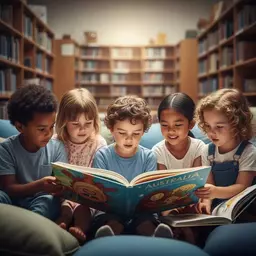Storytelling's Role in Education

In a world where attention spans are fleeting, storytelling stands as a beacon of engagement in education. It captivates, connects, and cultivates a love for learning among students. Discover how this powerful tool can transform the classroom experience.
What You Will Learn
- Storytelling enhances student engagement, making lessons more captivating and relatable.
- Narratives improve information retention compared to traditional teaching methods.
- Using stories in education fosters empathy and emotional intelligence among students.
- Integrating digital tools can elevate storytelling practices, making learning interactive and fun.
- VR and AI technologies offer new avenues for immersive storytelling experiences in the classroom.
The Transformative Power of Storytelling in Education
Educational storytelling breathes life into the curriculum, encouraging students to immerse themselves in the learning process. Below are key benefits and modern integrations. For more creative ideas, explore creative storytelling ideas for kids.
Core Benefits of Educational Storytelling
- 1 Engagement & Curiosity
- 2 Improved Retention
- 3 Enhanced Relatability
Emotional Intelligence through Narratives
- 1 Emotion Identification
- 2 Empathy Building
- 3 Conflict Resolution
Technology Integration in Storytelling
- 1 Digital platforms
- 2 Interactive e-books
- 3 Podcasting & audio
New Frontiers: VR & AI in Storytelling
- 1 VR Immersion
- 2 AI-driven narratives
- 3 Gamified experiences
The Importance of Storytelling in Education
Storytelling is more than just a means to entertain; it is an essential tool for education. As an educator and founder of Kids Book Guide, I’ve witnessed firsthand how stories can transform the classroom experience. When we engage children through narratives, we are not merely sharing tales; we are opening doors to learning that can inspire curiosity and foster personal connections.
At its core, educational storytelling involves using narratives to convey lessons, concepts, and values. Through the art of storytelling, we can make complex subjects relatable and accessible. This method breathes life into the curriculum, encouraging students to immerse themselves in the learning process.

Understanding the Concept of Educational Storytelling
Educational storytelling is about weaving lessons into narratives that resonate with students. When we frame information within a story, we help students visualize concepts, making them easier to grasp. This approach invites them to embark on a journey where facts are transformed into characters, conflicts, and resolutions.
- Engagement: Stories draw in students, capturing their attention and imagination.
- Retention: Narratives help students remember information better than traditional methods.
- Relatability: When students see themselves in stories, they can connect more deeply with the material.
By integrating storytelling into our classrooms, we not only teach academic content but also cultivate a love for learning. In my experience with Kids Book Guide, I’ve noticed that children are more likely to engage with literature when it’s presented as a captivating story rather than a lesson that feels disconnected from their lives. For more insights on improving reading skills, visit boost your child's reading skills.
Connecting with Students: The Role of Storytelling
Stories have the unique ability to bridge the gap between the educator and the student. They create a shared experience that fosters connection and understanding. By telling stories that reflect students' backgrounds and experiences, educators can cultivate an inclusive classroom environment.
- Empathy: Storytelling allows students to explore different perspectives, enhancing their emotional intelligence.
- Discussion: Engaging in storytelling opens up discussions, inviting students to share their thoughts and feelings.
- Collaboration: Students can work together to create or retell stories, reinforcing teamwork and communication.
When I incorporate storytelling into my lessons, I often see students light up as they relate to the characters or situations. This connection not only enriches their learning experience but also builds their confidence in expressing their thoughts.
Exploring the Emotional Intelligence Developments Through Storytelling
The journey through a well-told story can evoke a myriad of emotions, providing a powerful way to develop students' emotional intelligence. As we guide children through various narratives, we help them understand their feelings and those of others.

- Emotion Identification: Stories encourage students to recognize and articulate their emotions.
- Empathy Building: By stepping into characters' shoes, students learn to empathize with different viewpoints.
- Conflict Resolution: Storytelling often presents challenges that require resolution, teaching critical thinking and problem-solving skills.
As I’ve seen at Kids Book Guide, stories have the power to teach valuable life lessons, imparting wisdom that extends beyond the classroom. In nurturing emotional intelligence through storytelling, we prepare our students not only for academic success but for meaningful interactions in their lives.
Pro Tip
To enhance the storytelling experience in your classroom, consider incorporating sensory elements. For instance, use props related to the story or create a themed environment that reflects the narrative. This not only captivates students' attention but also helps them engage with the material on a deeper level, making the learning experience memorable and impactful.
Integrating Technology into Storytelling Practices
In today's digital age, integrating technology into storytelling practices can greatly enhance the educational experience for both teachers and students. As an educator and a passionate advocate for children's literature, I’ve seen firsthand how incorporating tech tools can make stories come alive in the classroom! These innovations not only engage students but also provide new avenues for expression and creativity.
- Digital storytelling platforms
- Interactive e-books
- Podcasting and audio storytelling tools
- Video editing software for narrative creation
These tools allow educators to create immersive narratives that draw students in, making them active participants in their learning journey. Imagine students not just reading stories, but also creating their own interactive versions with multimedia elements!
Exploring Digital Storytelling Tools for Educators
Digital storytelling tools have revolutionized the way we approach narrative in the classroom. These resources empower teachers to incorporate creativity while enhancing literacy skills. Some popular tools include:
- Storybird: An online platform that allows students to create beautiful visual stories.
- Toontastic: An app where kids can draw, animate, and narrate their own stories.
- Flipgrid: A video discussion platform where students can share their stories and feedback interactively.
By utilizing these tools, educators can foster an environment where storytelling becomes an engaging and collaborative experience. Encouraging students to explore their creativity through digital media can lead to profound learning outcomes! For more specific ideas, consider teaching narrative writing with picture books.
Using VR and AI in Storytelling: A New Frontier
The integration of Virtual Reality (VR) and Artificial Intelligence (AI) into storytelling practices opens up a whole new world for educational experiences. With VR, students can step into the shoes of characters, exploring settings and scenarios in a way that traditional storytelling can't match!
- VR storytelling experiences that transport students to different time periods or cultures.
- AI-driven interactive narratives that adapt to a student’s choices and responses.
- Gamified storytelling that encourages collaboration and problem-solving.
These advancements encourage students to immerse themselves in stories, enhancing their emotional connection and understanding. As a result, learners are not just passive recipients of information but active participants in their educational narrative.
Implementing Educational Technology to Enhance Storytelling
Using educational technology effectively can streamline the storytelling process and enrich the learning experience. I’ve found that when technology is aligned with educational goals, it can transform how stories are told and shared in the classroom. Here are some strategies to consider:
- Incorporate collaborative tools like Google Slides for group storytelling projects.
- Utilize platforms like Padlet to share and brainstorm story ideas.
- Leverage social media stories to connect with wider audiences on student-created narratives.
By leveraging these technologies, we can help students express their ideas in novel ways and engage them more deeply in their storytelling efforts. The goal is to make learning fun and interactive, as it truly should be!
Frequently Asked Questions About Storytelling in Education
What are the core benefits of storytelling in education?
Storytelling in education significantly enhances engagement and curiosity among students, improves their information retention compared to traditional methods, and makes learning more relatable by allowing students to connect with characters and situations on a deeper level.
How does storytelling help develop emotional intelligence?
Through narratives, students learn to identify and articulate emotions, build empathy by understanding diverse perspectives, and develop critical thinking and problem-solving skills through conflict resolution presented in stories.
What role does technology play in modern educational storytelling?
Technology, including digital storytelling platforms, interactive e-books, podcasting tools, VR, and AI, enhances educational storytelling by creating immersive, interactive, and personalized learning experiences. These tools allow students to actively participate in and even create their own narratives.
Can storytelling improve academic performance?
Yes, by making complex subjects more relatable and engaging, storytelling improves information retention and comprehension, which can lead to better academic performance across various subjects.
How can educators start incorporating storytelling into their classrooms?
Educators can begin by using narratives to introduce new topics, encouraging students to create their own stories using digital tools, incorporating sensory elements, and leveraging collaborative platforms for group storytelling projects.
Recap of Key Points
Here is a quick recap of the important points discussed in the article:
- Engagement: Storytelling captures students' attention and imagination, enhancing their learning experience.
- Retention: Narratives improve memory retention, helping students remember concepts better than traditional teaching methods.
- Empathy and Emotional Intelligence: Stories allow students to explore various perspectives, fostering empathy and emotional understanding.
- Technology Integration: Utilizing digital storytelling tools, VR, and AI can enhance engagement and creativity in storytelling practices.
- Collaborative Learning: Encouraging students to work together in storytelling promotes teamwork and communication skills.
Popular Posts
 As you navigate the vibrant world of children's literature, think about how a simple signature can t
As you navigate the vibrant world of children's literature, think about how a simple signature can t
 What if the right book could unlock your child's imagination and build their future? Understanding a
What if the right book could unlock your child's imagination and build their future? Understanding a
 Reading stories isn't just a pastime; it's a powerful catalyst for children's education. Australian
Reading stories isn't just a pastime; it's a powerful catalyst for children's education. Australian
 In the words of Aveline Carter, "The journey of discovering books can be just as exciting as reading
In the words of Aveline Carter, "The journey of discovering books can be just as exciting as reading
